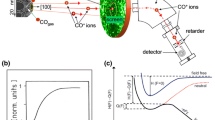15
sites on 1 cm2. To overcome this for the important class of alkali adsorbates on metals and semiconductors, two methods are presented. Common to both is the preparation of a highly nuclear spin-polarized atomic beam of 6Li in the one case and 8Li in the other. The latter isotope is radioactive and undergoes a β-decay with a half-life of 0.84 s. Li adsorbed on the close-packed Ru(001) surface is investigated. The longitudinal relaxation time, T1, is the main observable and is used to deduce the local electronic density of states [LDOS(EF,r=0)] and Li diffusion barriers. The second experiment uses 6Li as an adsorbate, also studied on Ru(001). The nuclear polarization is measured by beam foil spectroscopy. A novel particle detected (photon counting) Fourier transform NMR technique is demonstrated. This is done by observing the time-dependent flux of circularly polarized light emitted behind the foil after a 90° pulse has been employed at the surface. Electric field gradients and transverse relaxation times, T2, are thus determined. A large difference between T1 and T2 is traced to the dimensionality of the system.
Similar content being viewed by others
Author information
Authors and Affiliations
Additional information
Received: 21 March 1997/Accepted: 12 August 1997
Rights and permissions
About this article
Cite this article
Jänsch, H. NMR at single crystal surfaces . Appl Phys A 65, 567–572 (1997). https://doi.org/10.1007/s003390050623
Issue Date:
DOI: https://doi.org/10.1007/s003390050623




